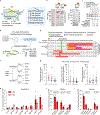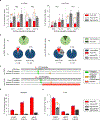CRISPR prime editing with ribonucleoprotein complexes in zebrafish and primary human cells
- PMID: 33927418
- PMCID: PMC8553808
- DOI: 10.1038/s41587-021-00901-y
CRISPR prime editing with ribonucleoprotein complexes in zebrafish and primary human cells
Erratum in
-
Author Correction: CRISPR prime editing with ribonucleoprotein complexes in zebrafish and primary human cells.Nat Biotechnol. 2022 Feb;40(2):273. doi: 10.1038/s41587-021-00939-y. Nat Biotechnol. 2022. PMID: 33986547 No abstract available.
Abstract
Prime editors have been delivered using DNA or RNA vectors. Here we demonstrate prime editing with purified ribonucleoprotein complexes. We introduced somatic mutations in zebrafish embryos with frequencies as high as 30% and demonstrate germline transmission. We also observed unintended insertions, deletions and prime editing guide RNA (pegRNA) scaffold incorporations. In HEK293T and primary human T cells, prime editing with purified ribonucleoprotein complexes introduced desired edits with frequencies of up to 21 and 7.5%, respectively.
© 2021. The Author(s), under exclusive licence to Springer Nature America, Inc.
Conflict of interest statement
Competing Financial Interests Statement
J.K.J. has financial interests in Beam Therapeutics, Chroma Medicine (f/k/a YKY, Inc.), Editas Medicine, Excelsior Genomics, Pairwise Plants, Poseida Therapeutics, SeQure Dx, Transposagen Biopharmaceuticals, and Verve Therapeutics (f/k/a Endcadia). K.P. has a financial interest in SeQure Dx, Inc.. L.P. has financial interests in Edilytics, SeQure Dx, Inc. and Excelsior Genomics. K.P. and D.Y.K. are paid consultants to Verve Therapeutics. K.C. is an employee, shareholder, and officer of Edilytics, Inc. J.K.J.’s, L.P.’s, K.C.’s, K.P.’s, and D.Y.K.’s interests were reviewed and are managed by Massachusetts General Hospital and Partners HealthCare in accordance with their conflict of interest policies. M.V.M. is an inventor on patents related to adoptive cell therapies, held by Massachusetts General Hospital and University of Pennsylvania (some licensed to Novartis). M.V.M. holds equity in TCR2 and Century Therapeutics, and has served as a consultant for multiple companies involved in cell therapies. The remaining authors declare no competing interests.
Figures


Comment in
-
Prime editing progress.Nat Methods. 2021 Jun;18(6):592. doi: 10.1038/s41592-021-01188-2. Nat Methods. 2021. PMID: 34099936 No abstract available.
References
Publication types
MeSH terms
Substances
Grants and funding
LinkOut - more resources
Full Text Sources
Other Literature Sources
Research Materials

